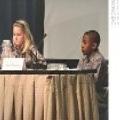At a youth forum in Washington, D.C., area teenagers heard from experts about the global problems of water supply and sanitation and discussed the challenges of providing enough safe, clean water to the world's population. About 80 high school students gathered at the World Bank to take on a global crisis.
"Today, of the world's six billion people, over a billion lack access to clean water, and 2.5 billion live without access to improved sanitation," Heidi Shoup, president of the World Affairs Council, the educational nonprofit which sponsored the event was quick to emphasize the severity of the crisis. "Each year, five million people die as a result of water-related illnesses. That's about one every six seconds." Malaria, schistosomiasis and intestinal worms are all water-related health issues. But World Bank water and sanitation specialist Peter Kolsky told the students that diarrheal disease is by far the biggest killer.
"The most important thing to know about diarrheal disease is it kills two million kids a year," he said. Ninety percent of those deaths are children younger than 5 years old, mostly in developing countries.
Diarrheal diseases like cholera spread when people drink water or eat food - or anything else - that has been contaminated with human feces. Kolsky tells the students to think of a typical 5-year-old child.
"Children eat dirt, you know? It's just life. And children lick things on the floor that they shouldn't lick." As a result, Kolskly explained, fields and floors can become a significant source of contamination.
According to the World Health Organization, close to 90 percent of diarrheal disease cases result from unsafe water supplies, inadequate sanitation or poor hygiene. Kolsky said that changing people's behavior can be the most difficult challenge - but that improved hygiene can also provide the greatest benefits, in terms of preventing disease. Just washing your hands after using the toilet and before eating and drinking, he told the students, can make a huge difference.
"You can reduce diarrheal disease 50 percent, in the world, if all of us washed our hands with soap at the right time." But, Kolsky explained, people want access to water and sanitation for many reasons besides disease prevention. When clean water for drinking, cooking and washing is not locally available, women and children have to fetch it for their families, often carrying heavy buckets over long distances for many hours each day.
The presentations prompted lively discussions with the high-schoolers in the audience, and one posed a question that got right to the heart of the day's topic: "What do you think that we - as, like, teenagers - could do to address this issue in our own communities?" One of the most compelling answers came not from the water and sanitation experts, but from another student - 10-year-old Marguerite Harris, from a local bilingual elementary school. She told the teenagers that her school had gotten involved with an organization called H2O for Life.
"H2O for Life partners schools here in the USA with schools in developing countries around the world," she said. The American students raise money to help provide students in the developing country - in this case, Nicaragua - with clean water, sanitation and hygiene education at their school. Marguerite says she and her classmates have learned a lot in the process.
"It really hit me when I learned that the burden of fetching water falls mostly on girls. They have to walk hours a day in the hot sun to fetch heavy buckets of water, instead of attending school like the boys." Amari Newman is also participating in the H2O for Life project.
"I feel really spoiled because I have all this water, and all these kids around the world have no water at all and are dying." He described some of the students' fund raising efforts, including a planned relay race. The students will get people to sponsor them with donations. To complete the race, Amari explains, the students will have to carry buckets of water, "the same amount of distance that children have to carry daily at our partner school." As World Affairs Council president Heidi Shoup told the students, it will be up to their generation to find ways to meet the world's water and sanitation needs. "Every one of you can be part of the solution to the world water crisis." By Véronique LaCapra Washington, D.C. 09 February 2009

